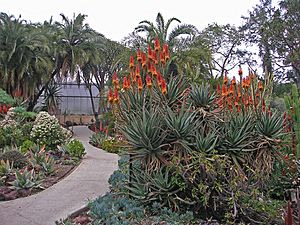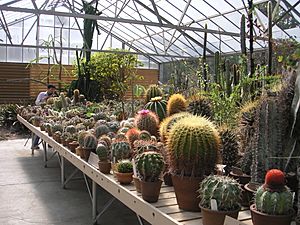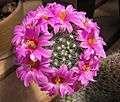Desert Garden Conservatory facts for kids
Quick facts for kids Desert Garden Conservatory |
|
|---|---|

Entrance to the Desert Garden Conservatory
|
|
| Type | cactus garden |
| Location | San Marino, California |
| Created | 1985 |
| Closed | |
| Open | Yes |
The Desert Garden Conservatory is a huge greenhouse filled with amazing plants. It's part of the Huntington Library, Art Collections, and Botanical Gardens in San Marino, California. This special building was built in 1985.
It sits right next to the 10-acre Huntington Desert Garden. This garden has one of the world's most important collections of cacti and other succulent plants. Many of these plants are rare or endangered species. The Conservatory is like a giant plant hospital and research center. It helps protect these unique plants for everyone to enjoy and learn from.
There are about 10,000 types of succulents around the world. About 1,500 of them are cacti. The Desert Garden Conservatory has over 2,200 different plants. These include more than 1,200 different species and many genera (groups of species).
The plants come from deserts all over the world. You can find plants from the southern United States, Argentina, Mexico, and even places like Madagascar and South Africa. This collection is super important for keeping plant biodiversity safe. It also helps teach people about these cool desert plants.
Contents
Helping Rare Plants Grow
Scientists are worried that many plants and animals might disappear. This could happen because of global warming and new buildings taking over their homes. To help, scientists are growing plants in safe places like the Conservatory. This is called "ex-situ cultivation." It's like a backup plan for plants that might lose their natural habitats.
The Huntington has a special program to protect endangered succulents. It's called International Succulent Introductions (ISI).
What is the ISI Program?
The main goal of the ISI program is to grow and share new or rare succulents. They give these plants to collectors, plant nurseries, and other gardens. This helps more people study and appreciate these amazing plants.
The ISI program shares up to 40 new succulent types each year. They don't sell plants taken directly from the wild. Instead, they only share plants grown in their nurseries. This means they don't harm wild plant populations.
Schick Hybrids: Colorful Desert Flowers
The Schick hybrids are special types of plants. They were created by mixing different kinds of desert plants. These hybrids can bloom many times in one season. As they get older, they produce even more flowers.
At the Huntington, these flowers usually start blooming in April. Then they bloom again in May, June, and July. Some even keep blooming into August, September, and October! These beautiful plants are also available through The Huntington's ISI program.
Images for kids
-
Inside the greenhouse -
Mammillaria boolii HBG 48842 -
Mammillaria fraileana HBG 59973 -
Crassulaceae "Pink-Pagoda" (Crassulaceae) -
Echeveria secunda (Crassulaceae)
See also
 In Spanish: Conservatorio del Jardín del Desierto para niños
In Spanish: Conservatorio del Jardín del Desierto para niños




















